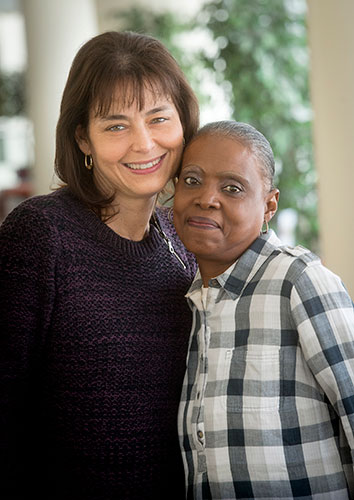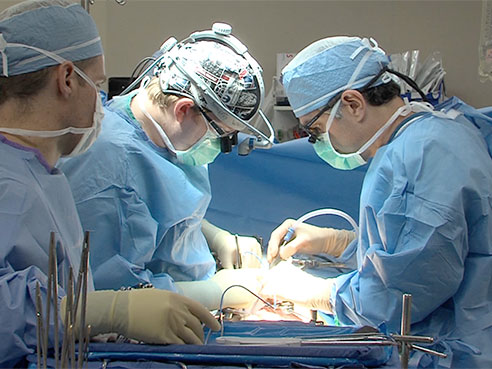 Deborah Lethgo and Eloise JenkinsAs far back as 2009, Deborah Lethgo was told she was going to need a liver transplant at some point in her life in order to survive. Earlier this year, Eloise Jenkins found out she would need a new liver in order to live.
Deborah Lethgo and Eloise JenkinsAs far back as 2009, Deborah Lethgo was told she was going to need a liver transplant at some point in her life in order to survive. Earlier this year, Eloise Jenkins found out she would need a new liver in order to live.
Their paths crossed July 31 when the 48-year-old Lethgo and the 58-year-old Jenkins became the first adults to receive transplants from a single donor liver at UAB Hospital. The more than 13-hour split-liver transplant was the first of its kind to be performed in Alabama.
“I’ve lived through a lot of things I probably wasn’t supposed to live through,” said Lethgo, an Atlanta, Georgia, resident who has battled acute encephalopathy, bladder cancer and two lengthy comas. “To be able to split an organ and transplant it to two adults is just amazing. I’m incredibly blessed.”
“I got the call that I was going to be transplanted on July 29, my birthday,” said Jenkins, who also had a kidney transplant at the same time as her liver transplant. “It was the greatest birthday present I could have received. To be the first person this happened to in Alabama? It’s such a blessing.”
UAB and Children’s of Alabama surgeons have previously performed split-liver transplants where one part of the liver was transplanted to an adult and the other to a small child. Those procedures are performed two to three times per year. For Lethgo’s and Jenkins’ transplants, the School of Medicine’s Division of Transplantation liver transplant team — Devin Eckhoff, M.D., Derek Dubay, M.D., Stephen Gray, M.D., and Jared White, M.D. — participated in the surgeries, which began before noon July 31 and finished around 2 a.m. Aug. 1.
Dubay and White performed the donor split, a more than four-hour procedure. Eckhoff and Gray then transplanted the two divided liver lobes to Lethgo and Jenkins.
“This type of procedure is performed around the United States approximately 15 times per year,” Dubay said. “It requires some technical expertise and a specific knowledge base to do it. A lot of the advancements we’ve made in our liver transplant outcomes and in splitting livers have largely been from anesthetic and perioperative care improvements. UAB Hospital has been very generous in providing us the infrastructure to do this — the dedicated anesthesiologists, perioperative teams and surgeons who work just with us on transplants. That’s what enabled this to happen.”
The operation was possible only because the deceased donor’s family honored his wishes that he be an organ donor upon death. For this particular donor, the lungs, heart, liver, kidneys and pancreas were all used to save others’ lives.
“The real hero in this is the donor family,” Dubay said. “That’s always such a tough situation for families, especially if they’ve just experienced a terrible event. But they still made the decision to be an organ donor and saved many lives from this one act of kindness. It was a truly heroic act.”
Lethgo and Jenkins have not met the donor’s family, but their love and admiration for them is evident.
“I can’t begin to explain how thankful I am to the donor’s family, for following through on his wishes,” Lethgo said. “I actually talk to my donor every day. I tell him, ‘Thank you for going through all of this for me.’”
“The impact this donor and his family have had on my life? How do you explain it?” Jenkins said. “That’s something that’s in the eye of the Lord. I don’t know what I could say to that family. I guess the only thing I can say is thank you, thank you, thank you.”
Transplant particulars
The liver is necessary for reasons beyond its ability to make bile. It’s involved in a multitude of physiological processes, including metabolism, regulating glucose levels, and filtering the blood of toxins ingested from things like medicine and food.
“It plays a role is so many metabolic processes that, if it’s not functioning well, a lot of things can go awry,” White said. “The heart, liver and kidneys work in concert, so if one fails the others follow suit sometimes. It also plays a role in the immunological process, so if the liver doesn’t work, it truly becomes a life-threatening problem.”
 The rare split-liver transplant took more than 13 hours and required a team of expert surgeons.The liver is essentially a big, vascular two-lobed sponge, which can be very difficult for surgeons to divide.
The rare split-liver transplant took more than 13 hours and required a team of expert surgeons.The liver is essentially a big, vascular two-lobed sponge, which can be very difficult for surgeons to divide.
When surgeons decide to split a liver to transplant to two adults, the two lobes have to be of adequate size to facilitate the transplants. In general, the transplants have to be performed with individuals considered to be normal weight or perhaps a little bit lighter than normal, especially for the recipient receiving the left side of the liver, which is slightly smaller than the right.
When surgeons procure the organ, they use sophisticated tools similar to a water flosser to split it. The instrument is calibrated so that it will divide the liver parenchyma without dividing the blood vessels in it. “So you essentially tease away the liver cells without dividing the underlying vascular structure that is there,” Dubay said.
The donor in this case was unique, adding to the case’s complexity. In most instances, there is one artery and one vein that go into the liver, and there is typically one outflow vein. This particular donor had four outflow veins that had to be dissected out, preserved and kept for implantation.
Surgeons have a CT scan performed and measure the volume of the liver to assess how large it is. Using markers, they determine which side is the left and which is the right, and then they determine the volume of the two lobes.
“When we know the volume of the lobes, we know then that they can go into a recipient up to a certain weight,” Dubay said. “And with the four outflow veins like there were in this instance, you have to make sure it is anatomically conducive to the donors. Fortunately, it was.”
The fact that the liver regenerates also enables surgeons to perform this type of transplant. After transplantation, livers will enlarge and gain about 85 percent of their original size within a month.
“We could see the right and left lobes getting bigger in these patients after they underwent CT scans after the transplant,” White said. “The liver regenerates in quick fashion.”
National need
More than 15,000 people are awaiting liver transplantation in the United States, and some 6,500 liver transplants are performed each year. That means 8,500 people per year are not receiving needed transplants, which makes the benefits of being able to use one liver to transplant two people obvious.
“One of the things that really sparked my interest in liver transplantation was that these patients are often very sick, very ill, and often at the brink of dying,” said White, who trained at UAB under Eckhoff and Dubay before finishing his fellowship and joining the liver transplant team. “When you see the patients postoperatively, getting their strength and their color back, and then see them months down the road and how gracious they are and how well they’re doing — it renews every day why we do what we do.”
UAB hopes to continue to grow its program to help those in Alabama and the Southeast who are among those needing liver transplants. The surgeons hope more split-liver transplants featuring two adult recipients will become more commonplace here and around the country as techniques continue to be honed.
A live-donor liver transplant program at UAB also is being pursued as are other infrastructure improvements and procurement capabilities.
“We’re able to offer the full spectrum of transplantation services at UAB for all abdominal and thoracic organs, and we’re trying to push the frontiers so we are able to transplant more patients and try to save more patients,” White said. “There are a lot of positive things happening that we hope will enable us to save more lives.”
| If you or a loved one is in need of a liver transplant or a second opinion about a liver condition, call 205-975-5691 or toll-free at 866-305-5691. You can also visit UAB Medicine’s liver transplant website for more information. Also, learn more about abdominal transplantation by visiting the Department of Surgery’s website. |